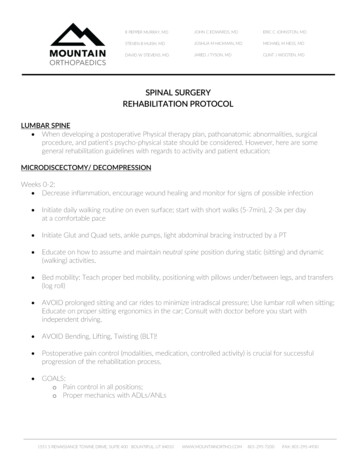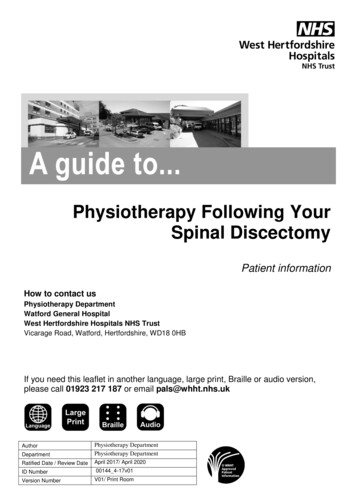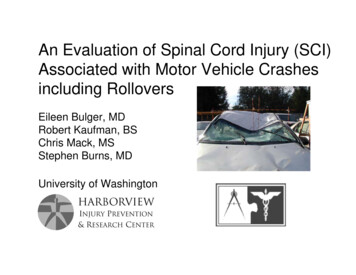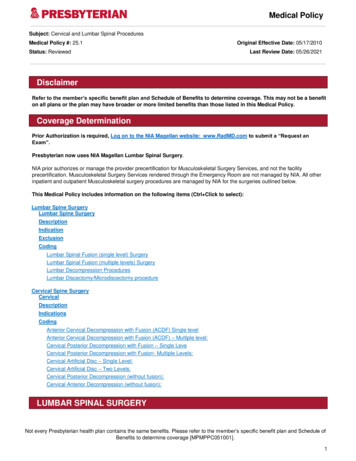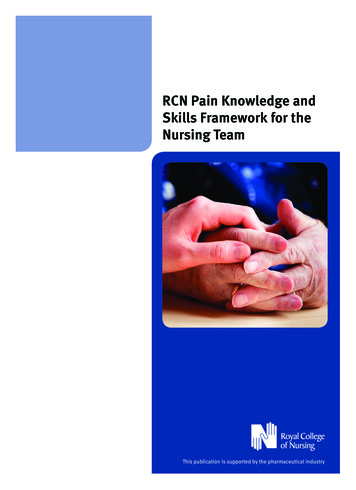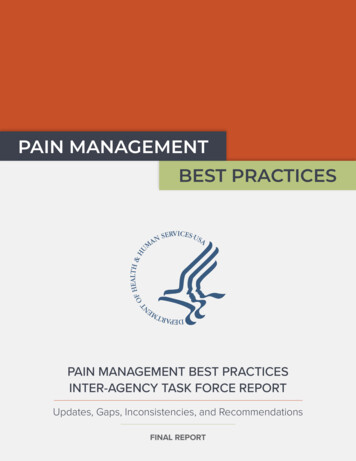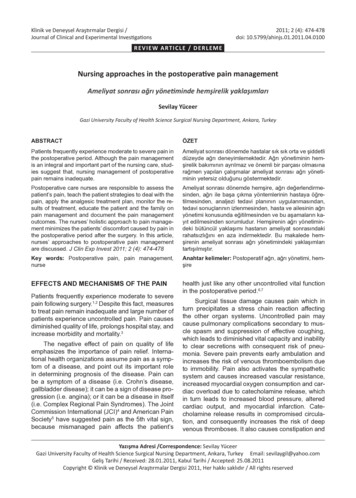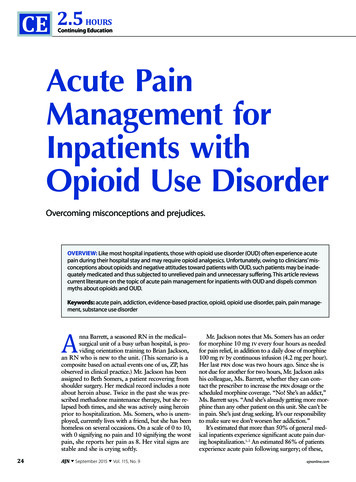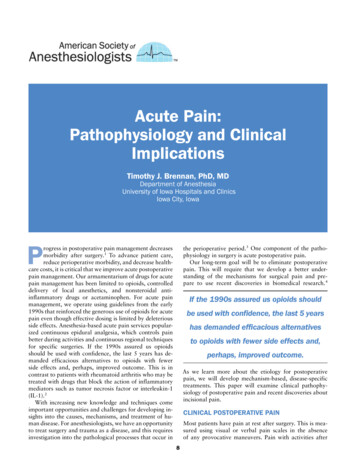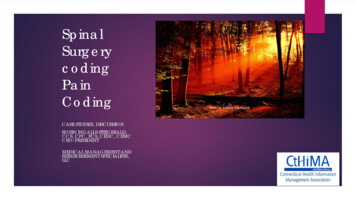
Transcription
SpinalSurgerycodingPainCodingCASE STUDIES, DISCUSSIONROBIN INGALLS-FITZGERALD,CCS, CPC, FCS, CEDC, CEMCCEO/PRESIDENTMEDICAL MANAGEMENT ANDREIMBURSEMENT SPECIALISTS,LLC
Agenda Discuss spinal procedures CPT PCS And more
Spinal Fusions- PCS codingSome of the most complex surgeries to code in ICD-10Spinal fusion is classified by the anatomic portion (column) fused and thetechnique (approach) used to perform the fusion. The fusion can include adiscectomy, bone grafting, and spinal instrumentation.
Spinal Fusions Anterior Column: The body (corpus) of adjacentvertebrae (interbody fusion). The anterior column can befused using an anterior, lateral, or posterior technique. Posterior Column: Posterior structures of adjacentvertebrae (pedicle, lamina, facet, transverse process, or“gutter” fusion). A posterior column fusion can beperformed using a posterior, posterolateral, or lateraltransverse technique. Approaches: Posterior or from the back (most common);anterior through a laparotomy
Spinal Anatomy
Devices Interbody fusion devices —e.g. BAK cages, PEEKcages, bone dowels Autologous Tissue Substitute —bone graft obtainedfrom the patient during the procedure. Bone graftsmay be harvested locally using the same incision, orfrom another part of the body requiring a separateincision. Harvesting requires a separate procedurecode ONLY when it is performed through a separateincision. Nonautologous Tissue Substitute —bone bank Synthetic Substitute —examples includedemineralized bone matrix, synthetic bone graftextenders, bone morphogenetic proteins (BMP)
Interbody Fusion DevicesThe interbody fusion device immobilizes the intervertebraljoint to stabilize the segment for fusion. It restores disc spaceheight and requires removal of all or part of the disc so thatthe device can be inserted into the disc space. More thanone device can be used at the same time.Device Materials: Carbon Ceramic Metal Plastic TitaniumTerms used: BAK cages Interbody Fusion Cage Ray-Threaded FusionCage PEEK Device/cage Interbody SpacerFixation Instrumentation (do not code)Rods, plates, screws, etc.
C-spine interbody deviceBone dowels
How to Choose Device Value If an interbody fusion device is used (alone or containing other materiallike bone graft), the procedure is coded with the device value InterbodyFusion Device If bone graft is the only device used, the procedure is coded with devicevalue Nonautologous Tissue Substitute or Autologous Tissue Substitutedepending on bone source If a mixture of autologous and nonautologous bone graft (with or withoutbiological or synthetic extenders or binders) is used, the procedure iscoded with device value Autologous Tissue Substitute
Spinal Fusions -7th character Thequalifier is the 7th character in fusions and throws off a lot of good coders. Choices are: Anterior approach anterior column Posterior approach posterior column Posterior approach anterior column What position is the patient in on the OR table? Supine vs prone Anterior column is the vertebral body Posterior column contains the bony protrusions Interbody fusion anterior column (anterior 2/3 of the vertebral body) Terms like articular facet joints, pedicles, lamina, spinous process– means posterior columnfusion
Figure 1Qualifier CharactersAnterior Approach, Anterior Column Posterior Approach, Posterior Column (1)(0)Posterior Approach, AnteriorColumn (J)Supine (face up) positioningProne (back up) positioningProne (back up) positioningIncision made on the front or side of the Incision made on the back side of the bodybodyIncision made on the back side ofthe bodyVertebral body is fusedVertebral body is fusedStructures on the posterior spine are fusedQualifier Examples for Anterior Column FusionsProcedureApproachQualifierAnterior lumbar interbody fusion (ALIF) Incision made in front of the spine through aminilaparotomy or laparoscopy0 Anterior Approach, AnteriorColumnPosterior lumbar interbody fusion (PLIF) Incision made through a midline incision in the backJ Posterior Approach, AnteriorColumnExtreme lateral interbody fusion (XLIF) Incision made in the patient’s side0 Anterior Approach, AnteriorColumnDirect lateral interbody fusion (DLIF)0 Anterior Approach, AnteriorColumnIncision made in the patient’s sideTransforaminal lumbar interbody fusion Incision made through a midline incision in the back(TLIF)J Posterior Approach, AnteriorColumn
BMP with Fusion When a mixture of autologous and nonautologous bone graft with orwithout biological or synthetic extenders or binders is used to render a jointimmobile, code the procedure with the device value “autologous tissue substitute.” No additional code is reported.
Integral vs Non-Integral ProceduresSome procedures are integral to the fusion and cannot be codedseparately. Take this example:Via an open posterior approach: Exploration of previous fusion L3-S1 Removal of segmental instrumentation L3-S1 L2-L3 complete bilateral laminectomy for decompression Right L2-L3 transforaminal lumbar interbody fusion with BMP, locallyharvested morcelized autograft, morcelized allograft andMedtronic PEEK cage L2-S1 segmental instrumentation with Medtronic Solera 5-5 system L2-L3 posterolateral/posterior arthrodesis with locally harvestedmorcelized autograft and BMP
Procedure #1So what would we code? anterior spinal fusion (right L2-L3 transforaminal lumbarinterbody fusion posterior spinal fusion (L2-L3 posterolateral/posteriorarthrodesis removal of the previously placed segmental instrumentationL3-S1(needs 2 codes)
Integral vs Nonintegral In the example even though 6 procedures were done, wewill only use 4 PCS codes.What is NOT separately coded? exploration of the old fusion site; Laminectomy L2-S1 segmental instrumentation
And the codes are 0SG00AJ - anterior fusion with cage 0SG0071 - posterior fusion w/ autograft 0SP004Z - Removal of instrumentation L3-L5 0SP304Z – Removal of instrumentation L5-S1
Procedure #2-Let’s CodeOperation Performed: L3-S1: Lumbar laminectomy, decompression ofcauda equina, posterior spinal fusion, segmental instrumentation, andmorselized local bone grafting supplemented with bone from bone bank. 0SG1071 Fusion 2-4 lumbar joint with autologoustissue substitute, posterior approach posteriorcolumn, open0SG3071 Fusion lumbosacral joint with autologoustissue substitute, posterior approach posteriorcolumn, open
Procedure # 3 L2-L5 posterior lumbar interbody fusion using autologousbone graft L2-L5 discectomy L2-L5 pedicle screw instrumentation Harvesting bone graft from right iliac crest through separateincision Open posterior approach
Not codedNOT CODED: Pedicle screw instrumentation at L2-L5Need to code:Posterior lumbar interbody (i.e. ant. column) fusionDiscectomyBone graft harvest
And the codes are 0SG107J posterior lumbar interbody fusion 0SB20ZZ discectomies 0QB20ZZ harvesting bone from iliac crest Coding Clinic 2nd qtr 2014 specifies that a discectomy is almostalways performed at the same time as spinal fusion surgery. Anadditional code should be assigned. Typically, a fusion involvespartial removal of the disc and should be coded as excision ofdisc. If, however, the provider documents “total discectomy,” itshould be coded as a disc resection.
Procedure Example #4 Lumbar decompression L4-L5 and L5-S1 bilateralforaminotomies L3 decompression laminectomy L4-L5 and L5-S1 discectomy L4-L5 and L5-S1 transforaminal lumbar interbody fusion withautogenous iliac crest graft and BAK cage L4-L5 and L5-S1 posterolateral fusion with autogenous iliac crestgraft Right posterior iliac crest bone graft harvest through separateincision L4-S1 segmental instrumentation Open posterior approach
What do we code? transforaminal lumbar interbody fusion (i.e. anterior column fusion) posterior spinal fusion discectomyharvesting of bone graft
And the codes are 0SG00AJ (L4-L5) and 0SG30AJ (L5-S1) for the transforaminal lumbarinterbody fusion 0SG0071 (L4-L5) and 0SG3071 (L5-S1) posterior spinal fusion 0SB20ZZ and 0SB40ZZ discectomy at 2 levels 0QB20ZZ for harvesting of bone graft
#5 Posterior Cervical Fusion andInstrumentation, C5-T1Via an open posterior approach, facet screws were placed at C5and T1. Bone grafts using a combination of locally harvestedmorselized bone and bone bank allograft material were tamped into place. A Harrington rod was affixed to the spine with the facetscrews for completion of the construct.0RG2071- fusion 2 or more cervical vertebral joints with autologoustissue, posterior approach, posterior column0RG4071- fusion cervicothoracic vertebral joint with autologoustissue, posterior approach, posterior column
360 degree Fusion and DocumentationFrustration360 degree fusions involve both anterior and posterior columns.Sometimes like hunting for a needle in a haystack to find the documentationfor posterior portion of the surgeryDid you ever see an op note stating “posterolateral gutter was packed withbone graft”? This is a posterior column fusion!
360 degree Fusion Impacts DRG (453- 455) A fusion of both the anterior and posterior columns of thespine performed with two incisions Anterior incision for the anterior column fusion Posterior incision for the posterior column fusion Does not impact DRG (459-460) A fusion of both the anterior and posterior columns of thespine through a single incision.
What the 360 fusion looks likeAnterior column fusionPosterior column fusion
Decompressive Laminectomy/FacetectomyDone to relieve pressure on either the spinal cordor the spinal nerves.Root operation RELEASE
Spinal cord vs Peripheral Spinal Nerve Myelopathy Spinal cord involvement Radiculopathy- Nerve root involvement
#6 Let’s Code:Laminectomy for nerve root decompression at L2-L5 and posterior interbodyspinal fusion using PEEK cage performed at L3-L5.0SG10AJ - Fusion 2 or more lumbar vertebral joints with interbody fusion device, posteriorapproach, anterior column, open approach01NB0ZZ - Release of lumbar nerve, open approachWe assign a code for the laminectomy at L2 only because: If laminectomy is done at the same level as the spinal fusion it is included and notcoded separately.
01N table - use to build our PCSlaminectomy codes for nerve root decompression
#7- Decompressive CervicalLaminectomiesA patient with cervical myelopathy undergoes an open totaldecompressive laminectomy at C3, C4, C5 and a partialdecompression at C6.00NW0ZZ – release of cervical spinal cord, open approachThe spinal cord, a single body part, is the focus of this procedure. Releasealways codes the body part being decompressed, not the part being operatedon. So we need only one PCS code for this procedure.We need the 00N table because we are decompressing (releasing) the spinalcord, not the nerve roots. The spinal cord is body part “central nervous systemand cranial nerves.”
00N table - use to build our PCSlaminectomy codes for spinal cord decompression
CPT Coding for Spinal FusionsProcedure #1 Operation Performed: L3-S1: Lumbar laminectomy, decompression ofcauda equina, posterior spinal fusion, segmental instrumentation, andmorselized local bone grafting supplemented with bone from bone bank.
And the CPT codes are 22612Posterior Arthrodesis, lumbar 1st level 22614 each additional level 22614 each additional level 22842 post. segmental instrumentation 3-6 vertebral segments 20930- morselized allograft spine surgery only 20936 autograft, spine only, local same incision Do not code the laminectomy because it wasperformed on the same interspace as the fusion
Procedure example 2 L2-L5 posterior lumbar interbody fusion using autologous bone graft L2-L5 discectomy L2-L5 pedicle screw instrumentation Harvesting bone graft from right iliac crest through separate incision Open posterior approach
And the codes are22630- Arthrodesis, posterior interbody techniqueincluding laminectomy and/or discectomy to prepareinterspace; lumbar22632 – Each additional interspace22632 - Each additional interspace20937 – autograft for spine surgery only, morselized22842- Posterior segmental instrumentation 3-6vertebral segments
Procedure Example #3 Lumbar decompression L4-L5 and L5-S1 bilateral foraminotomiesL3 decompression laminectomyL4-L5 and L5-S1 discectomyL4-L5 and L5-S1 transforaminal lumbar interbody fusion withautogenous iliac crest graft and BAK cageL4-L5 and L5-S1 posterolateral fusion with autogenous iliac crestgraftRight posterior iliac crest bone graft harvest through separateincisionL4-S1 segmental instrumentationOpen posterior approach
And the codes are63030 – L3 laminectomy22633 – comb post. w/ post. Interbody technique includinglaminectomy and/or discectomy, single interspace and segment;lumbar22634 – each additional interspace22853- insertion interbody device w/ anterior instrumentation inconjunction w/ interbody arthrodesis, each interspace (L4-5)22853- (L5-S1)20937- autograft for spine surgery only22842- posterior segmental instrumentation 3-6 vertebral segments
#4 Posterior Cervical Fusion andInstrumentation, C5-T1Via an open posterior approach, facet screws wereplaced at C5 and T1.Bone grafts using a combination of locally harvestedmorselized bone and bone bank allograft material weretamped in to place.A Harrington rod was affixed to the spine with the facetscrews for completion of the construct.
And the codes are 22600 – C5-6 Fusion 22614 – C6-7 Fusion 22614 – C7-T1 Fusion 22840 - Posterior nonsegmental instrumentation 20930 – Morselized allograft 20936 – Autograft locally harvested
Multiple Decompressive CervicalLaminectomiesA patient with cervical myelopathy undergoes anopen total decompressive laminectomy at C3,C4, C5 and a partial decompression at C6.63015 – laminectomy w/ exploration and/ordecompression of spinal cord and/or cauda equinawithout facetectomy, foraminotomy or discectomy,more than 2 vertebral segments, cervical
Laminectomy with Fusion Laminectomy for decompression at L2-L5 and posterior interbody spinalfusion using PEEK cage performed at L3-L5 63030- laminectomy at L2 22630 – fusion L3-4 22632 – fusion L4-5 22853 cage application, each interspace 22853 cage application, each interspace Do not code laminectomies performed at the same levels as the fusion
Vertebroplasty & Kyphoplasty- CPTPercutaneous vertebroplasty is a minimally invasive procedure duringwhich the surgeon injects “bone cement” (methyl methacrylate) into avertebra(e) to fill vertebral fractures and restore spinal integrity.Percutaneous vertebral augmentation (a.k.a., kyphoplasty or balloonassisted percutaneous vertebroplasty) is a similar procedure adding theuse of an inflatable balloon to jack up the damaged vertebra(e) prior tomethyl methacrylate injection.No CPT Category I or Category III codes describe cervical kyphoplasty.To report cervical kyphoplasty, use 22899 Unlisted procedure, spine.
What’s the difference To distinguish kyphoplasty from standard vertebroplasty, lookfor documentation of a mechanical device to augmentvertebral height prior to injection of bone cement, such as: Balloon Balloon-assisted Bone tamp IBT KyphX (a common brand name for the bone tamp)
What’s BundledVertebroplasty 22511-22512 and Kyphoplasty 22513-22515 code ranges include: imaging guidance bone biopsy at the same level Fracture reduction 22310, 22315, 22325, 22327 when performed at the samelevel moderate sedationNote vertebroplasty and kyphoplasty are unilateral or bilateral; modifier -50 is notappropriate
SHOULDER REPLACEMENTAssign PCS and CPT codes:Patient undergoes right reverse total shoulder arthroplasty withrepair of a torn supraspinatus and biceps tenodesis. To ensureadditional external rotation strength, the latissimus muscle washarvested and transferred around the humerus, then securedto the greater tuberosity.ORRJ00Z23472-RT
HIP PROCEDURESAssign both PCS and CPT codes for this case:Patient with right total hip replacement presents with a fractured femoral stem.Through an open incision, the broken component was removed, a new femoralcomponent was cemented in place. The acetabular liner was also replaced.0SRR0J9 replace rt hip femoral surface, synthetic substitute, cemented, openapproach0SUA09Z Supplement rt hip, acetabular surface, with liner, open approach0SPR0JZ Removal synthetic substitute rt hip, femoral surface open approach0SP909Z Removal liner rt hip, open approach27134-52, RT
Pain Management Injections
You need to know:Approach:EpiduralTransforaminalFacetType of InjectionAnestheticSteroidNeurolytic agentSpinal level treated# of spinal levels treatedUnilateral or bilateralIs fluoro/ultrasoundguidance allowed
Epidural injections – 62320-62323Done to relieve back, neck, extremity pain due tocompression of spinal nerve roots caused by HNP or spinalstenosis due to osteoarthritis.Codes changed in 2017 to distinguish with and withoutimaging guidance.62320-cervical or thoracic injection without imaging guidance.62321 – cervical or thoracic with fluoro or CT guidance62322 lumbar or lumbosacral injection without imaging guidance62323 – lumbar or lumbosacral injection with imaging guidance (fluoro or CT)
Epidural Steroid injectionsThe approach is through the midline directly into the epiduralspace between vertebrae. This is the most common type of ESI.Anesthetic may be mixed with the steroid.AKA:oInterlaminaroInterlaminar epiduraloESIoTranslaminar Epidural
Key Coding Points When imaging guidance is used, contrast injection is notseparately reportable. These codes are used to report administration of variousnon-neurolytic, diagnostic or therapeutic substances.Codes are reported only once even if multiple substancesare administered during a single injection. Code choice is based on the region where theneedle/catheter enters the body. Codes are reportedonly once even if the substance spreads or the cathetertip moves into another spinal region.
Transforaminal injections 64479-64484This ESI approach that may be needed if patient has scar tissue from oldinjuries or prior surgery that doesn’t allow effective spread of the steroid intothe epidural area with the interlaminar method.Also known as a “nerve block,” in a TFSI the needle is placed alongside thenerve as it exits the spine and medication is injected into the nerve, allowingit to travel up into epidural space from the side.
A visual You can see in thispicture where theneedle is inserted intothe foramen (opening)At the side of the joint.
Code Descriptions64479 Injection, anesthetic agent and/or steroid, transforaminal epidural; cervical or thoracic, with imaging guidance,single level 64480 Injection, anesthetic agent and/or steroid, transforaminal epidural; cervical or thoracic, with imaging guidance,each additional level (List separately in addition to code for primary procedure)64483 Injection, anesthetic agent and/or steroid, transforaminal epidural; with imaging guidance, lumbar or sacral, singlelevel 64484 Injection, anesthetic agent and/or steroid, transforaminal epidural; with imaging guidance, lumbar or sacral, eachadditional level (List separately in addition to code for primary procedure)
TFSI Guidelines Code PER LEVEL, not per injection. Do NOT code fluoro guidance separately as it is included in the codedescription for the injection. Multiple injections at the same level on the same side are only reportedonce.
Bilateral injections64479- 64484 are unilateral procedures; and because there areseparate nerves on each side of the spine, these proceduresmay be performed bilaterally at the same spinal level(s).Per CPT Assistant Sept. 2005:“When a transforaminal injection is performed on the oppositeside, the work may involve redraping and positioning of thepatient. Therefore, when performing bilateral transforaminalepidural injections at a single spinal level, modifier 50 [Bilateralprocedure] is appended to the appropriate code(s).”
Spinal Fusions- PCS coding Some of the most complex surgeries to code in ICD-10 Spinal fusion is classified by the anatomic portion (column) fused and the . 20937- autograft for spine surgery only. 22842- posterior segmental instrumentation 3 -6 vertebral segments
